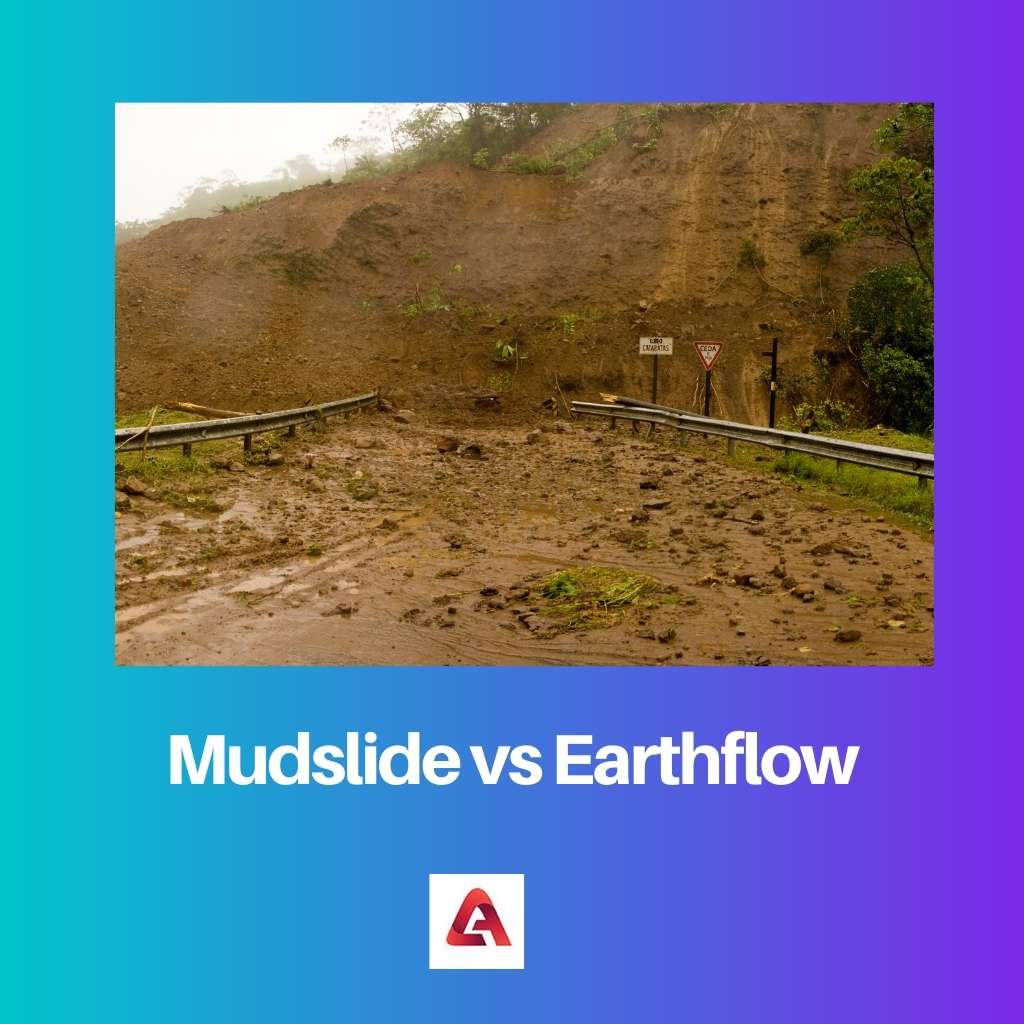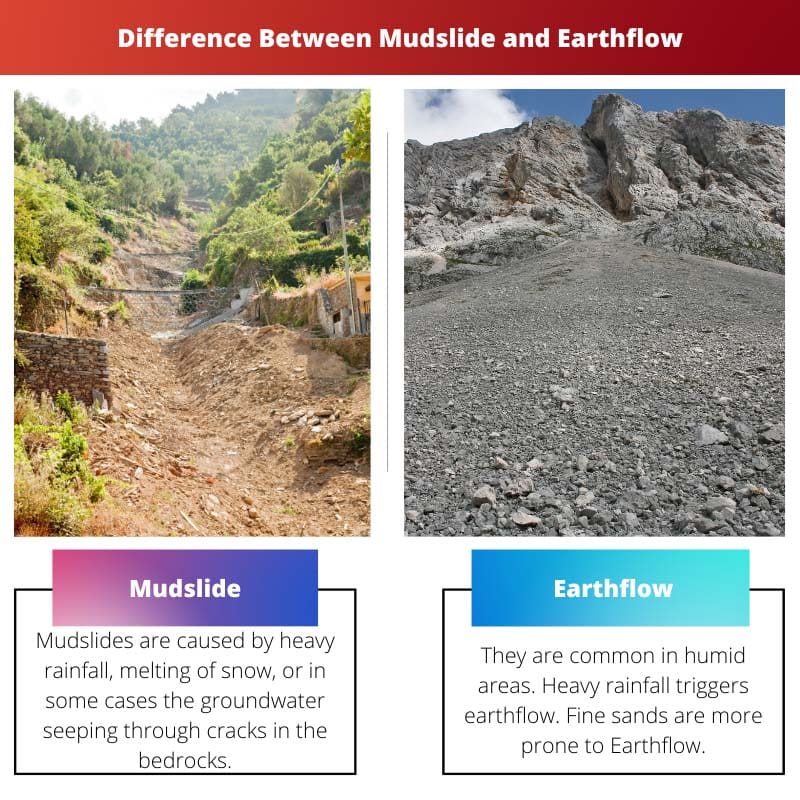Natural calamities are disastrous. They cause huge damage and even cost lives. They are common in steep or slope-like areas. It can occur in mountains coastal areas or even underwater bodies.
There are various types of landslides. The name differs depending on the place of occurrence and the consistency of the debris. Mudslide and Earthflow are two types.
Key Takeaways
- Mudslides involve the rapid movement of water-saturated debris, while earthflows consist of slow-moving, saturated soil and rock material.
- Mudslides have a higher water content than earthflows, resulting in a more fluid movement.
- Mudslides pose a greater threat to property and human life due to their speed, while earthflows cause damage gradually over time.
Mudslide vs Earthflow
Mudslide is a rapid movement of mud or debris down a slope, triggered by heavy rainfall or other natural causes. Earthflow is a slower and more gradual movement of soil and other materials down a slope, caused by saturation of the ground due to heavy rainfall or other factors.

The substrate of the mudslide is wet and fully or partially mixed with water. The amount of clay in mudslides is higher which makes it more fluid.
The term mudslide was used by the media to refer to mudflows. They are common in the United States. Volcanoes and glaciers also cause mudslides.
Fine soil particles become saturated with water and they flow down the slope due to the force of gravity. This is called Earthflow. This is common in mountains. The speed of earthflow changes from place to place.
The amount of water in the earth that is sliding determines the speed of the movement.
Comparison Table
| Parameters of Comparison | Mudslide | Earthflow |
|---|---|---|
| Composition | Mud, water, and rock particles | Moist soil |
| Velocity | Fast | Slow |
| Water quantity | High | Low |
| Types | Mudflow, lahar, and jökulhlaups | Pyroclastic, Clay, and Silt |
| Example | Sierra Leone and Uttarkhand | Gros Ventre and Slumgullion |
What is Mudslide?
Mudslides are caused by heavy rainfall, melting of snow, or in some cases the groundwater seeping through cracks in the bedrocks. All these causes the soil to mix up with an excess amount of water to form a substrate of muddy consistency.
Heavy rain on mountains can erode the soil layer and thus can lead to mudslides.
The flow of this muddy substance depends on the water content, the topography of the land, and also the size of soil grains. The increase in water content increases the flow initiation.
As the mudslide begins to move, it picks up the sediments on their way down. These picked-up particles are present in the front of the mudslide. This is pushed by the muddy soil that follows it.
Mudslides can cause heavy damage. They are made up of rocks, mud, water, and other debris. They have a strong current and can move houses and bury a place in seconds.
The largest mudslide in history occurred due to a volcanic eruption in the USA. It was caused by the eruption of Mount St. Helens in Washington. A majestic amount of 2.3km3 of the substrate has been displaced during this.
The areas that are at risk of mudslides are areas with frequent wildfires. The areas where human activities have to lead to the loss of vegetation and erosion of soil. Mountain slopes and foothills are also in danger.
Banks of rivers and lakes can also experience this. People living in this area are evacuated if heavy rainfall occurs as it increases the risk.

What is Earthflow?
They are common in humid areas. Heavy rainfall triggers earthflow. Fine sands are more prone to Earthflow. These sand particles are made moist with heavy rainfall and then they eventually start moving.
The substrate is not muddy like that of in mudslides but it is moist. This may take minutes or years to start depending on the availability of water.
They mainly occur on hill slopes. It has been known as a different type of landslide since the early 20th century. Earthflow is slower and it is covered by solid substances. It is carried down by a flow from the middle of the moving debris.
When the soil gets saturated by rainfall the shearing strength of the soil decreases. The wet slope thus begins to move down due to less friction.
Earthflows can also be made of granular soil materials. The velocity of this also depends upon the water content of the debris. Earthflows can block roads, and destroy buildings.
In places with high rainfall draining the slope properly is the precautionary measure followed. Slopes in which more sediments have been laid by human activities are also at risk.
Some of the examples of Earthflow are the thistle earthflow that occurred in Utah, Mangataikapua earthflow that occurred in New Zealand, etc. It can cause casualties or even kill people. Rescue teams are available to help when this kind of disaster occurs.

Main Differences Between Mudslide and Earthflow
- A Mudslide is the movement of debris that is muddy in texture while Earthflow is caused by the movement of moist earth or soil debris
- Mudslide is faster compared to Earthflow. Since Mudslide is rich in fluid it moves at a greater velocity
- The amount of water in a mudslide is higher than an Earthflow. The debris of Earthflow is just moist not fluidly
- The particles in a mudslide are small and of the size of clay. Soil rich in clay is very susceptible to mudslides whereas, earthflows include large particles of soil. They may also bring the trees and plants on their way
- Examples of mudslides include Sierra Leone in 2015 and Uttarkhand in 2013. Examples of Earthflow are Gros Ventre, Wyoming, and Slumgullion, Colorado.

- https://search.proquest.com/openview/7967dd752ecd858eabaf5ca62c9d7813/1?pq-origsite=gscholar&cbl=18750&diss=y
- https://link.springer.com/article/10.1007/s10346-004-0040-2
